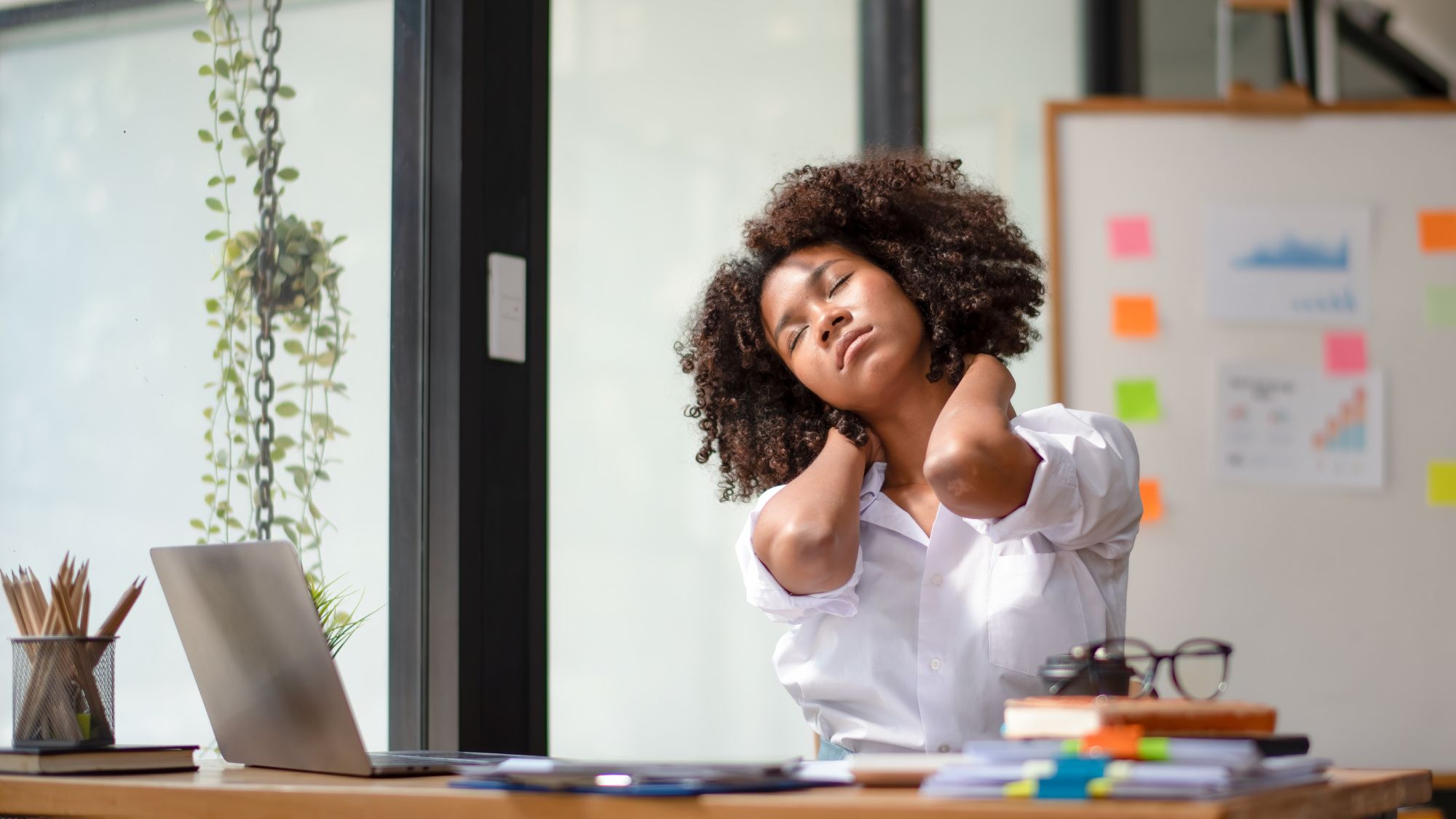"Desk exercises" are the latest trend taking over TikTok - here's whether little and often can boost your fitness
Break up those sedentary days.


The latest thing to go viral on TikTok? Desk exercises - but before you freak out at the thought of doing a pigeon pose in a pencil skirt, let us explain. Because yes, they can actually be a brilliant way to break up sedentary days and can be done without disturbing your workflow, too.
If you're wondering why you might benefit from adding some desk exercises to your day, answer this: have you ever considered just how many hours a day you spend sitting down? According to research from the British Journal of Sports Medicine, people with desk jobs spend 75% of their working hours sitting.
While that study was published in 2015, times have changed a lot since then. You know that working from home more frequently often results in less daily movement, with UK Active research suggesting that some people sit for as much as 14 hours a day when working from home. Assuming you're also sleeping for the recommended eight hours, you'd be spending just two hours of your day moving.
The impact of that is worrying. You know that not moving enough is bad for you, and sitting has previously been dubbed the "new smoking" because of how badly it can impact our health. "Moving regularly throughout the day is associated with improved circulation, cognition and even immunity - just to name a few," explains Shona Vertue, personal trainer and yoga instructor.
While sitting for a short period of time isn't harmful to your health - far from it - sitting for hours without a break can hit you hard. One small study from earlier this year found that eight hours of sitting - broken up only by bathroom breaks - was more damaging for people's health than eight hours of sitting broken up by five-minute walks every hour. The latter sitting style reduced blood sugar levels throughout the day substantially and blood sugar spikes after eating by almost 60%.
Then there's your posture and pain that's at risk from sitting, says Hollie Grant aka The Pilates PT. "If you're doing a lot of sitting, even when cautious about your posture, you may start to see muscle weakness and pain. You may get more hunched and experience back pain, tight hip flexors and weak glutes," she says.
That's where desk exercises come in - a simple, free and effective way to strengthen the muscles most impacted by our daily desk hours. Keep scrolling for a PT's pick of the best, and don't miss our guides to home workouts, walking workouts and workouts for beginners, while you're here.
Marie Claire Newsletter
Celebrity news, beauty, fashion advice, and fascinating features, delivered straight to your inbox!
Your guide to desk exercises
How effective are desk exercises?
"As soon as you mention desk exercises, people picture themselves in the office trying to do squats and looking like a fool," shares Grant. "But it doesn't have to be that way. Just getting up and moving is the most important thing."
Try this: start your desk exercise routine with a short walk around your floor every hour or so. "Loosening and engaging your muscles throughout the day is a great addition to your current exercise routine," says Grant.
Trainer and yoga instructor Shona Vertue adds that, often, desk stretches are a simpler way for busy people to fit movement into their day, saying: "You need to support your body to stay strong, fit and mobile, and a desk-based exercise series can be a convenient way to integrate healthy movement into a busy day."
She aims to stand or stretch for ten minutes every 90 minutes, alongside 30 minutes of more rigorous activity outside of working hours.
Should desk exercises replace my other workouts?
While desk exercises aren't a replacement for your daily workout, they can improve both mobility and flexibility if done repeatedly, she continues.
One recent 2022 study published in the Scandinavian Journal of Medicine & Science in Sport even concluded that the little-and-often approach to fitness is the best way to boost your overall health than longer periods of exercise done every other day or spread across the entire week.
Aim to do these alongside your regular workouts - they really shouldn't take any longer than five to ten minutes and promise to improve daily aches and pains tenfold.
5 best desk stretches and exercises
1. Pec stretch
What? "Your pecs shorten when your arms are extended out in front of you, which you do all day long when you're at a computer," says Grant.
That's where a pec stretch comes in, which can lengthen the muscle to ease the strain. "One of the best ways to do this is placing your arm on a door frame at 90 degrees and leaning your body through the frame," says Grant. The bonus of that stretch is that you have to get up to do it, but for a super quick desk-friendly version, try the chest butterfly.
How? Interlace your hands behind your head with your elbows outwide. Lean back, letting your face point towards the ceiling. "Think about lifting your boobs and ribcage up to the ceiling and lengthening out the spine so you're no longer in that big curved position," adds Grant.
How long for? Try the stretch for 30 seconds, coupled with the other movements below.
@mad_fit ♬ Sticky - Drake
2. Neck stretch
What? "Your neck is actually supposed to curve slightly backwards in the opposite direction to our thoracic spine," explains Grant. "As you spend so much time looking down at your computers, it gets lengthened and we can lose that nice curve, so we should be thinking about stretching in the opposite way," says Grant.
How? Try neck rotations, making sure you "lift the chin and curve the neck backwards," explains the expert. Crossing your hands onto your shoulders, tilt your neck back and turn your head in a circle.
How long for? Repeat three times, then do it on the opposite side.
@sydneejainefitness ♬ original sound
3. Hip stretch
What? "Sitting down shortens your hip flexors [the muscles that run down the front of the hip, into the quad], making them tight," says Grant. The classic hip flexor stretch is done in a low lunge position, stretching the hip flexor on the back leg. That's not quite realistic in an office but the couch stretch is a good adaptation to do at your desk.
How? The couch stretch is done by standing in front of your chair and placing your right foot onto the seat, sole facing up. Slightly bend your left leg to deepen the stretch on the right leg.
How long for? At least 30 seconds on each side.
@mackfamilychiro ♬ Work Out (Talkbox) - Adam Tahere
4. Glute stretch
What? "You can’t go wrong with a glute stretch," says Vertue. This exercise is key to waking up your bum after sitting on it for a long time, as well as lengthening your compressed lower back.
How? "Sit up tall in your chair and cross your ankle over the opposite knee, lifting out of your hips and keeping your spine long as you lean forward over your legs," explains Vertue.
How long for? Aim for 30 seconds on each side.
@stormiebrooks_ ♬ Blue Blood - Heinz Kiessling
5. Wrist stretch
What? It's not really a surprise if your wrists feel tight. You use your wrists to stabilise when you type, "without doing any of the rotation that they should be", according to Vertue, so now is the time to take them to their full range.
How? Take your right arm in front of you with your elbow bent. Hold your right arm in your left hand just below your wrist bone. Start turning your wrist in a circle without moving the rest of your arm. Ideally, follow all of the videos above if you have time, too.
How long for? 30 seconds on each side.
Fancy following along with an entire routine, rather than piecing together your own with the above moves?
Vertue swears by the below routine for simple, at-home stretching. It can even be office appropriate if you have meditation rooms or the like. No yoga mat or equipment needed.
Do seated exercises work?
Short answer: according to PT's Hollie Grant and Shona Vertue, yes, they do - but not in replacement of your other workouts.
A little-and-often approach to fitness can be a seriously effective way of making sure you're not only working out, but stretching, too, key for protecting your muscles, joints, and avoiding injury.
Case in point: one recent 2022 study even found that "a little bit of daily activity is more beneficial than longer periods of exercise spread out across the week."

Chloe Gray is a freelance journalist who writes and talks about health, fitness, and wellbeing through a feminist lens. She was part of the launch team for Stylist magazine's fitness brand, Strong Women, and has written for i news, Women's Health, Red magazine, Good Housekeeping, Refinery29, and more. She's all about building mental and physical strength, eating delicious food that fuels you well, and making the fitness industry more accessible and enjoyable. She's also a qualified fitness trainer and research nerd, so you can be sure everything you read is backed by proper science.
-
 Vintage sales, flower festivals and unique brunches - 7 fun and frivolous things to do this bank holiday
Vintage sales, flower festivals and unique brunches - 7 fun and frivolous things to do this bank holidayBy Jadie Troy-Pryde
-
 How Ben Affleck feels about dating after his divorce from Jennifer Lopez
How Ben Affleck feels about dating after his divorce from Jennifer LopezHe's taking it slow
By Iris Goldsztajn
-
 Dior travels to Kyoto for a cherry blossom-inspired fashion show
Dior travels to Kyoto for a cherry blossom-inspired fashion showHere's everything you need to know
By Clementina Jackson